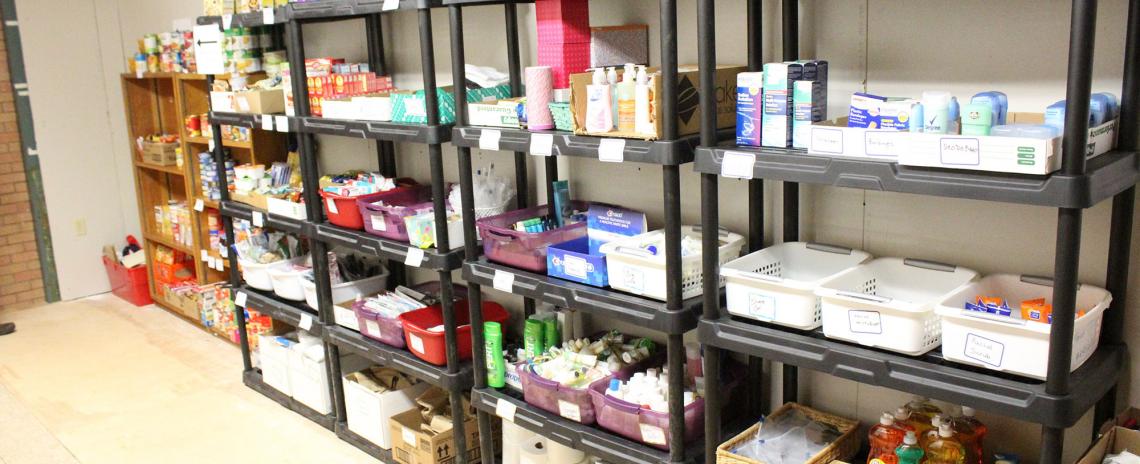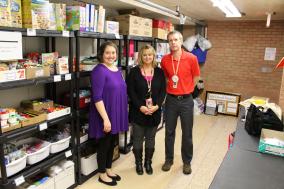The power of giving: The proof is in the pantry
The power of giving: The proof is in the pantry
By Tyler Dahlgren
NCSA Communications Specialist
At Hastings High School, faculty and students alike are discovering the power of giving.
The proof is in the pantry.
The idea for an on-site food and supply pantry at the school first came about last year. The pantry itself, located across the hall from the office at the bottom of a set of stairs, opened in April. It’s been gaining traction and involvement since.
“We heard of some other schools doing similar things, specifically Ralston, so we went out there and visited their program,” said Katie Funkey, drama teacher at Hastings. “It seemed like a solution to the problems we were seeing every day, but we didn’t know where to start.”
That was just last school year, and if Funkey and her colleagues didn’t know where to start, they sure figured it out. It’s early November, and the pantry is stocked to the brim with canned goods, ramen noodles, crackers, fruit snacks and other household items such as soap, toilet paper and deodorant.
The pantry opens near the end of every Friday, and there is currently 25-30 students at Hastings that access it on a weekly basis.
“We’d love to see higher numbers, because we know there is a higher need,” Hastings Public Schools liaison Amy Swayze said. “We are currently, as a district, above 60-percent as far as free lunch rates, so we know there is a much higher need.”
And yet, Swayze said, the faces that come through to collect necessary items every week are the same. The students accessing the pantry are the ones that truly need the support.
“Everyone that comes through has been very grateful, considerate, and just taken what they need,” Funkey said. “They are very thoughtful about what they need and what they can get by on, and have been very appreciative since the beginning.”
Pantry organizers have seen reluctance from students that may need assistance but don't want to ask for it or take it. High schoolers are a proud group. So they've been flexible, meeting students before school or after. Whatever arrangement needs to be made will be made, as long as the student gets help. Counselor Jeff Bittfield's office is near the pantry, and he shows up with a key whenever called upon.
"We don't want that to ever be a reason for kids not to come," Funkey said.
The pantry has not only been beneficial for students in need, but for the rest of the student body, which has been increasingly eager to contribute and support, perhaps because the person that benefits could be anyone they pass in the halls at HHS.
Funkey said one unexpected bonus is that the pantry has served as a conversation piece for students not in need of supplies. Students with the luxury of security that their locker neighbor might not enjoy experience an eye-opening call to get involved.
“I’ll be unloading my car with supplies and a student will say ‘Wow, Mrs. Funkey, that’s a lot of soup! Who needs that much soup?’,” Funkey said. “And I answered ‘Well, almost 60-percent of your classmates.’”
Hastings Tigers, along with the rest of the community, have gotten on board.
Twenty-five of Funkey’s Drama Club members, participating in “Trick-or-Treat So Kids Can Eat”, went out Monday night to collect goods. Each one came back with one or two big bags of food.
FFP (freshman homerooms), as a part of their gratitude program, has plans to sponsor weekly items for the pantry. The Key Club is putting on a contest to see who can come up with the most items with a big incentive: The winner gets Eileen’s Cookies.
“The kids were super excited to trick-or-treat, and even more excited to bring that food right back into the school and put it on these shelfs,” Funkey said. “That warmed my heart, and was really great to see.”
It’s an intimate kind of charity, which likely has a lot to do with the pantry’s success. Swayze said the students can personalize their goodwill, and though individual satisfaction isn’t why anyone gives, it’s nice to know their deeds ultimately better the lives of fellow students.
“When kids are out there donating themselves or picking up their donations, they know that those items are going to somebody, though they might not personally know them, that is in the classes they take or at the lunch tables they sit at,” Swayze said.



